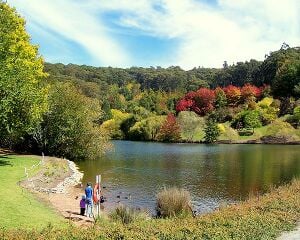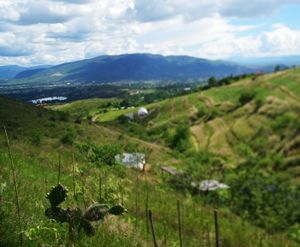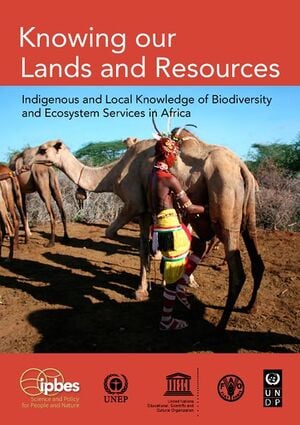
This page is the beginnings of a portal for Australia community action in response to Ecological emergency. See Ecological restoration for topic overview.
Community action projects[edit | edit source]
Ecosystem restoration[edit | edit source]

 How China’s most ‘futuristic’ city restored its mangroves, dialogue.earth (Jul 11, 2024)
How China’s most ‘futuristic’ city restored its mangroves, dialogue.earth (Jul 11, 2024)  Community-led approach to mangrove restoration in southern Thailand based on beekeeping, news.mongabay.com (Jun 18, 2024)
Community-led approach to mangrove restoration in southern Thailand based on beekeeping, news.mongabay.com (Jun 18, 2024)  EU passes law to restore 20% of bloc’s land and sea by end of decade, theguardian.com (Jun 17, 2024)
EU passes law to restore 20% of bloc’s land and sea by end of decade, theguardian.com (Jun 17, 2024)
Ecosystem restoration is the process of halting and overturning degradation, resulting in cleaner air and water, extreme weather mitigation, better human health, and recovered biodiversity, including improved pollination of plants. Restoration encompasses a wide continuum of practices, from reforestation to re-wetting peatlands and coral rehabilitation.[1]
Citizen Science[edit | edit source]
Citizen Science refers to the involvement, participation and engagement of citizens in local or online (global) scientific work relevant to the citizens' interests, usually as a hobby, often as a passion.
Biodiversity[edit | edit source]
- Rewilding Australia, WWF Australia, added 11:57, 14 April 2021 (UTC)
Wikipedia:
- Conservation in Australia: Conservation in Australia is an issue of state and federal policy. Australia is one of the most biologically diverse countries in the world [citation needed], with a large portion of species endemic to Australia. Preserving this wealth of biodiversity is important for future generations.
- Animal habitats like reefs and forests must be preserved in order to preserve population and diversity of animal species. Conservation is vital for future study and for field research to be undertaken, and because biological richness is an unmeasurable aesthetic that may be developed into commercial recreational attractions.
- According to Janine Benyus, the potential for advances in biomimicry in Australia are great because the extreme weather and conditions found here provide an excellent evolutionary incubator. Research on natural processes can only occur if habitat is preserved and organisms continue to thrive. Rainforests such as the Daintree have immeasurable value.
- Federal and State governments manage protected areas and national parks; a number of non-governmental organizations are also involved in conservation.
Environment quality[edit | edit source]
Clean Up Australia, (Wikipedia): Clean Up Australia Limited is a not-for-profit Australian environmental conservation organisation founded by Australian Ian Kiernan, and co-founder Kim McKay, in 1989. It works to foster relationships between the community, business and government to address the environmental issues of waste, water and climate change. Since its inception, Clean Up Australia has grown to include other projects and campaigns including Business Clean Up Day, Schools Clean Up Day, Clean Up the Alps, Clean Up the Kimberley and Clean Up the World. The organisation is behind Clean Up Australia Day, as well as other environmental projects and campaigns.
Trees, woodland and forest[edit | edit source]
- Wikipedia:Forests of Australia: Australia has many forests of importance due to significant features, despite being one of the driest continents. Australia has approximately 147 million hectares of native forest, which represents some 19% of land use. The majority of Australia's trees are hardwoods, typically eucalypts, rather than softwoods like pine.
Coasts[edit | edit source]
One of the notable issues with marine conservation in Australia is the protection of the Great Barrier Reef. The Great Barrier Reef's environmental pressures include water quality from runoff, climate change and mass coral bleaching, cyclic outbreaks of the crown-of-thorns starfish, overfishing, and shipping accidents.[2]
Urban and rural connections[edit | edit source]
section needed
Ecological emergency[edit | edit source]

There is consensus in the scientific community that the current environmental degradation and destruction of many of Earth's biota are taking place on a "catastrophically short timescale". Scientists estimate that the current species extinction rate, or the rate of the Holocene extinction, is 1,000 to 10,000 times higher than the normal, background rate. Habitat loss is the leading cause of both species extinctions and ecosystem service decline. Two methods have been identified to slow the rate of species extinction and ecosystem service decline, they are the conservation of currently viable habitat and the restoration of degraded habitat. The commercial applications of ecological restoration have increased exponentially in recent years. In 2019, the United Nations General Assembly declared 2021–2030 the UN Decade on Ecosystem Restoration. W
UN Decade on Ecosystem Restoration[edit | edit source]

 Green Deal: pioneering proposals to restore Europe's nature by 2050 and halve pesticide use by 2030, ec.europa.eu (Jun 22, 2022)
Green Deal: pioneering proposals to restore Europe's nature by 2050 and halve pesticide use by 2030, ec.europa.eu (Jun 22, 2022)  The farmers restoring Hawaii’s ancient food forests that once fed an island, theguardian.com (Jun 17, 2022)
The farmers restoring Hawaii’s ancient food forests that once fed an island, theguardian.com (Jun 17, 2022)
The UN Decade on Ecosystem Restoration 2021-2030 is a rallying call for the protection and revival of ecosystems all around the world, for the benefit of people and nature. It aims to halt the degradation of ecosystems and restore them to achieve global goals. The United Nations General Assembly has proclaimed the UN Decade and it is led by the United Nations Environment Programme and the Food and Agriculture Organization of the United Nations. The UN Decade is building a strong, broad-based global movement to ramp up restoration and put the world on track for a sustainable future. That will include building political momentum for restoration as well as thousands of initiatives on the ground.[3]
The decade was conceived as a means of highlighting the need for greatly increased global cooperation to restore degraded and destroyed ecosystems, contributing to efforts to combat climate change and safeguard biodiversity, food security, and water supply. W
See also[edit | edit source]

